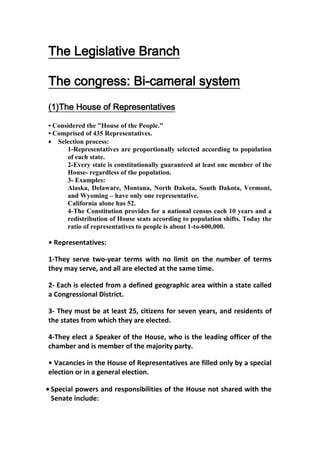
legislative Branch in details
- 1. The Legislative Branch The congress: Bi-cameral system (1)The House of Representatives • Considered the "House of the People." • Comprised of 435 Representatives. Selection process: 1-Representatives are proportionally selected according to population of each state. 2-Every state is constitutionally guaranteed at least one member of the House- regardless of the population. 3- Examples: Alaska, Delaware, Montana, North Dakota, South Dakota, Vermont, and Wyoming – have only one representative. California alone has 52. 4-The Constitution provides for a national census each 10 years and a redistribution of House seats according to population shifts. Today the ratio of representatives to people is about 1-to-600,000. • Representatives: 1-They serve two-year terms with no limit on the number of terms they may serve, and all are elected at the same time. 2- Each is elected from a defined geographic area within a state called a Congressional District. 3- They must be at least 25, citizens for seven years, and residents of the states from which they are elected. 4-They elect a Speaker of the House, who is the leading officer of the chamber and is member of the majority party. • Vacancies in the House of Representatives are filled only by a special election or in a general election. Special powers and responsibilities of the House not shared with the Senate include:
- 2. 1- The power to bring charges of impeachment against the President and Supreme Court Justices. 2- All bills for raising revenue must originate in the House. 3- The House selects the President in cases where no presidential candidate receives a majority of electoral votes. In such cases, each state delegation has one vote. (2)The Senate • "Upper Chamber” • Comprised of 100 Senators. The selection process: 1-Each state is entitled to two senators. 2-example: Wyoming, with an estimated 480,000 persons, has representation equal to that of California, with its population of 32,270,000. 3- For election purposes, senators are divided into three classes; one class stands for election every two years. This ensures that there are always experienced legislators serving in Congress. Senators: 1- They serve six-year terms, with no limit on the number of terms they may serve. The Constitution requires that U.S. 2-they must be at least 30 years of age, citizens of the United States for at least nine years, and residents of the states from which they are elected. • Vacancies in the Senate are generally filled by appointment by the governor of the state where the vacancy exists. • The Vice President of the United States serves as the President of the Senate, voting only in cases of a tie.
- 3. •The Senate has several unique powers to itself differ from house which are: 1- In cases of impeachment of the President or a member of the Supreme Court, the full Senate conducts the trial and acts as jury. 2- The Senate must confirm presidential appointments to the Supreme Court, lower federal courts, and key positions within the Executive Branch before the appointees can take office. 3-The Senate approves or rejects international treaties negotiated by the President. The powers of the legislative Branch: Legislation must pass both houses before it is presented to the President to be signed into law. The broad powers of the whole Congress are spelled out in Article I of the Constitution: To levy and collect taxes; • To borrow money for the public treasury; • To make rules and regulations governing commerce among the states and with foreign countries; • To make uniform rules for the naturalization of foreign citizens; • To coin money, state its value, and provide for the punishment of counterfeiters; • To set the standards for weights and measures; • To establish bankruptcy laws for the country as a whole; • To establish post offices and post roads; • To issue patents and copyrights; • To set up a system of federal courts; • To punish piracy; • To declare war; • To raise and support armies; • To provide for a navy; • To call out the militia to enforce federal laws, suppress lawlessness,
- 4. or repel invasions; • To make all laws for the seat of government (Washington, D.C.); • To make all laws necessary to enforce the Constitution. Oversight of the Executive Branch: Congress may hold hearings to investigate the operations and actions of the Executive Branch to ensure that it is carrying out the law with integrity. Investigations are conducted to gather information on the need for future legislation, to test the effectiveness of laws already passed, to inquire into the qualifications and performance of members and officials of the other branches, and, on rare occasions, to lay the groundwork for impeachment proceedings Congress has the power to publicize investigations and their results. Most committee hearings are open to the public and are widely reported in the mass media. Congressional investigations thus represent one important tool available to lawmakers to inform the citizenry and arouse public interest in national issues.